 Kia Sportage: Vehicle load limit
Kia Sportage: Vehicle load limit
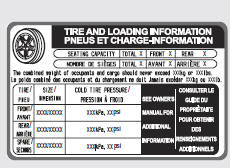
Tire and loading information label The tire label located on the driver's door sill gives the original tire size, cold tire pressures recommended for your vehicle, the number of people that can be in your vehicle and vehicle capacity weight. Steps for determining correct load limit 1. Locate the statement "The combined weight of occupants and cargo should never exceed XXX kg or XXX lbs.'' on your vehicle's placard. 2. Determine the combined weight of the driver and passengers that will be riding in your vehicle. 3. Subtract the combined weight of the driver and passengers from XXX kg or XXX lbs. 4. The resulting figure equals the available amount of cargo and luggage load capacity. For example, if the "XXX" amount equals 635 kg (1400 lbs), and there will be five 68 kg (150 lbs) passengers in your vehicle, the amount of available cargo and luggage load capacity is 295 kg (650 lbs). 635-340 (5 x 68) = 650 kg) or (1400-750 (5 x 150) = 295 lbs. 5. Determine the combined weight of luggage and cargo being loaded on the vehicle. That weight may not safely exceed the available cargo and luggage load capacity calculated in Step 4. 6. If your vehicle will be towing a trailer, load from your trailer will be transferred to your vehicle. Consult this manual to determine how this reduces the available cargo and luggage load capacity of your vehicle.
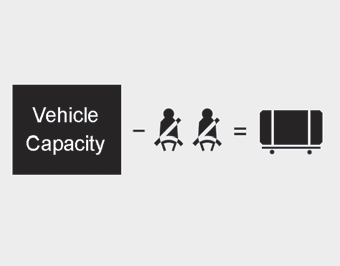
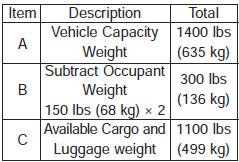
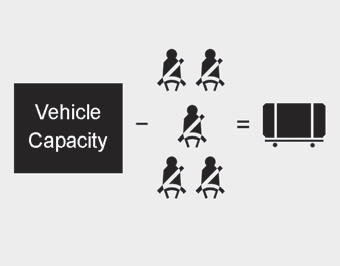
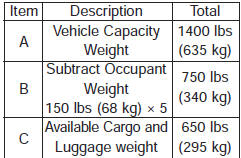
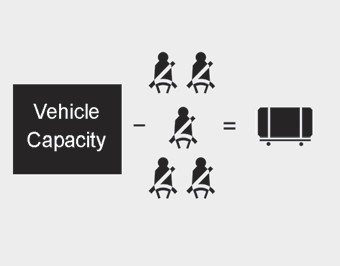
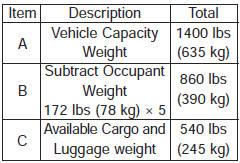
Refer to your vehicle's tire and loading information label for specific information about your vehicle's capacity weight and seating positions. The combined weight of the driver, passengers and cargo should never exceed your vehicle's capacity weight. Compliance label The compliance label is located on the driver's door sill. The label shows the size of your original tires and the inflation pressures needed to obtain the gross weight capacity of your vehicle. This is called the GVWR (Gross Vehicle Weight Rating). The GVWR includes the weight of the vehicle, all occupants, fuel and cargo. This label also tells you the maximum weights that can be supported by the front and rear axles, called Gross Axle Weight Rating (GAWR). To find out the actual loads on your front and rear axles, you need to go to a weigh station and weigh your vehicle.Your dealer can help you with this. Be sure to spread out your load equally on both sides of the centerline.
WARNING - Over loading • Never exceed the GVWR for your vehicle, or the GAWR for either the front or rear axle. • Do not load your vehicle any heavier than the GVWR, or either the maximum front or rear GAWR. If you do, parts on your vehicle can break, and it can change the way your vehicle handles. This could cause you to lose control and crash. Also, overloading can shorten the life of your vehicle.
NOTICE • Overloading your vehicle may cause damage. Repairs would not be covered by your warranty. Do not overload your vehicle. • Using heavier suspension components to get added durability might not change your weight ratings. Ask your dealer to help you load your vehicle the right way.
The label will help you decide how much cargo and installed equipment your vehicle can carry. If you carry items inside your vehicle - like suitcases, tools, packages, or anything else - they are moving as fast as the vehicle. If you have to stop or turn quickly, or if there is a crash, the items will keep going and can cause an injury if they strike the driver or a passenger.
WARNING - Loose cargo Items you carry inside your vehicle can strike and injure people in a sudden stop or turn, or in a crash. • Put things in the cargo area of your vehicle. Try to spread the weight evenly. • Never stack items, like suitcases, inside the vehicle above the tops of the seats. • Do not leave an unsecured child restraint in your vehicle. • When you carry something inside the vehicle, secure it. • Do not drive with a seat folded down unless necessary.
 Overloading
Overloading
CAUTION - Vehicle weight The gross axle weight rating (GAWR) and the gross vehicle
weight rating (GVWR) for your vehicle are on the manufacturer's label attached to
the driver's door. Exce ...
 Homelink wireless control system
Homelink wireless control system
Your new mirror comes with an integrated HomeLink Universal Transceiver, which
allows you to program the mirror to activate your garage door(s), estate gate, home
lighting, etc. The mirror actua ...
See also:
Checking and adding oil
Location of the filler cap and dipstick
Volvo recommends Castrol oil products
NOTE
Before checking the oil:
• The car should be parked on a level surface.
• If the engine is warm, wait fo ...
Shift Lock Release
This allows you to move the shift
lever out of Park if the normal
method of pushing on the brake
pedal and pressing the release
button does not work.
1. Set the parking brake.
2. Remove the ...
